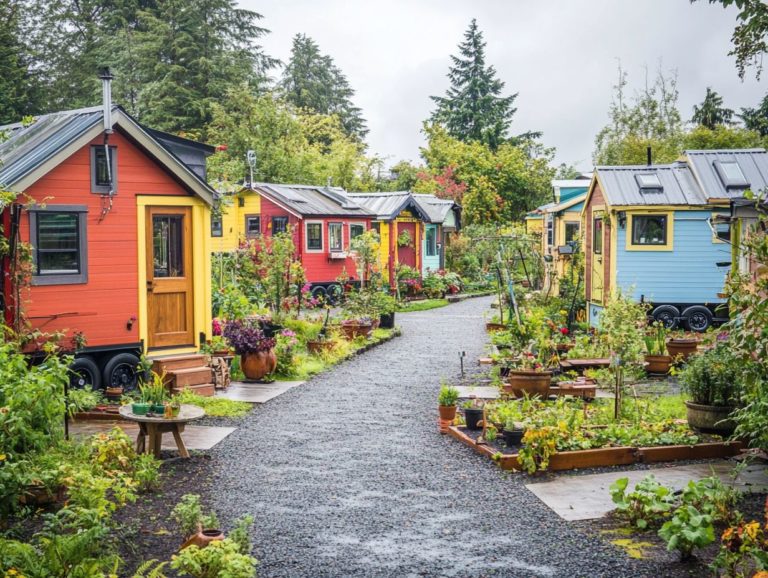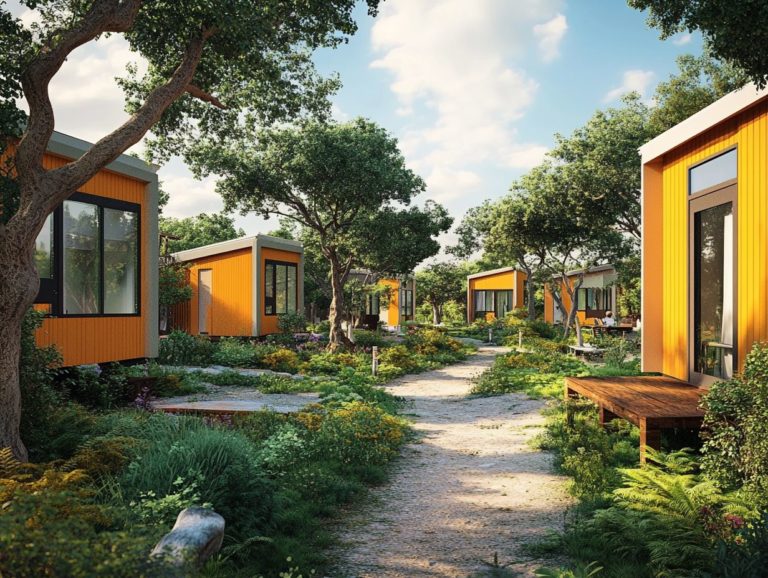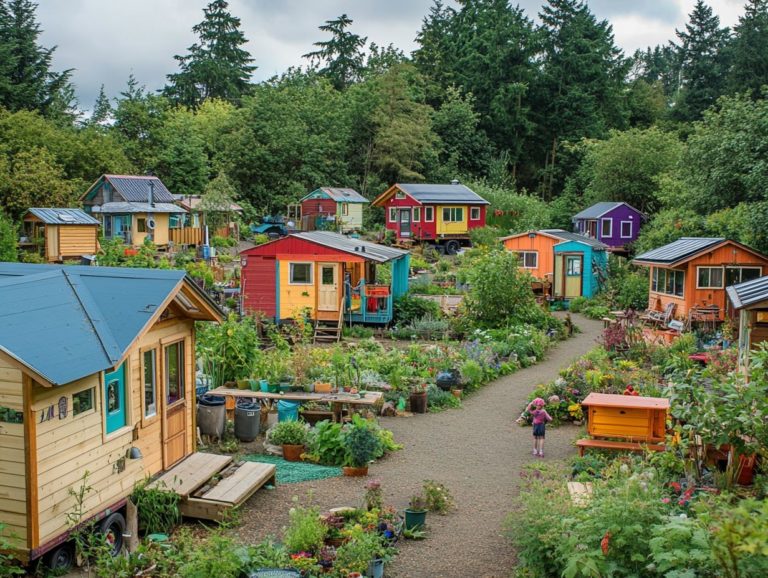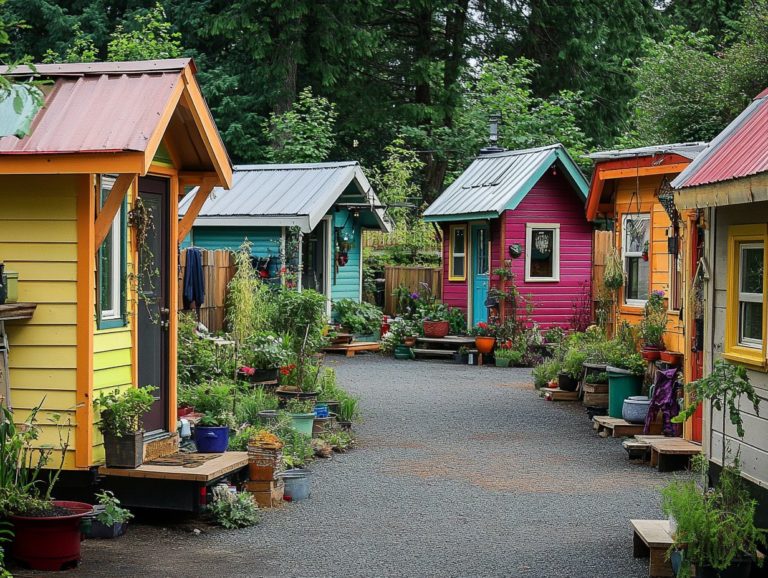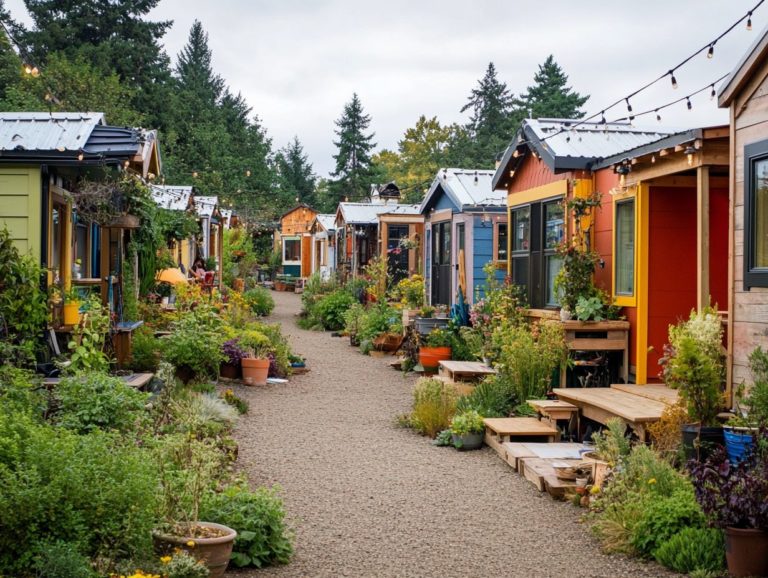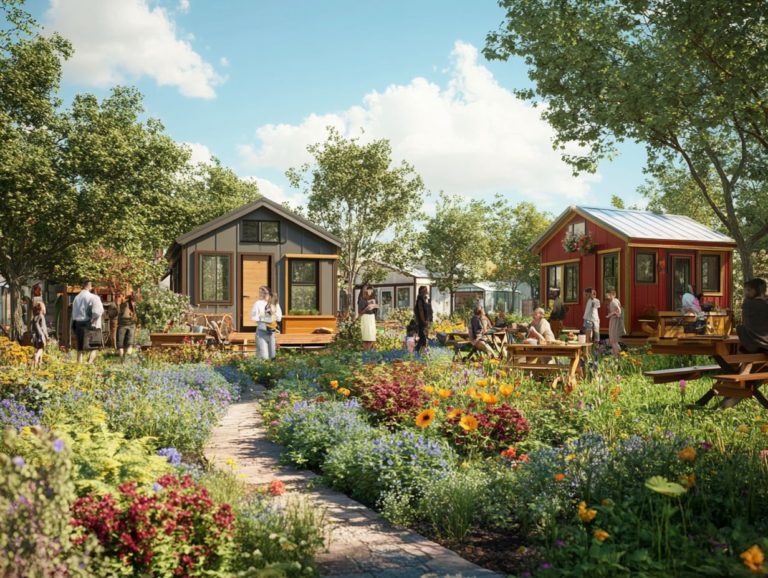5 Things to Look for in Tiny House Communities
Tiny house communities are emerging across the country, captivating individuals like you who are in search of a simpler, more sustainable lifestyle.
With their delightful aesthetics and unique communal living features, these micro-neighborhoods present a refreshing alternative to conventional housing.
As you contemplate joining one of these communities, consider five essential factors: location, amenities, community dynamics, and affordability.
Whether you’re a curious newcomer or fully prepared to make the leap, this guide will assist you in discovering the perfect fit for your tiny living aspirations.
Contents
- Key Takeaways:
- 1. Location and Surrounding Area
- 2. Community Rules and Regulations
- 3. Amenities and Shared Spaces
- 4. Community Dynamics and Social Activities
- 5. Cost and Affordability
- Why Tiny House Communities Are Transforming Lives
- Frequently Asked Questions
- What are the top 5 things to look for in tiny house communities?
- What factors should I consider when choosing a location for a tiny house community?
- What type of amenities should I expect in a tiny house community?
- What kind of rules do most tiny house communities have?
- How can I ensure a tiny house community is sustainable?
- What is the importance of a sense of community in tiny house communities?
Key Takeaways:
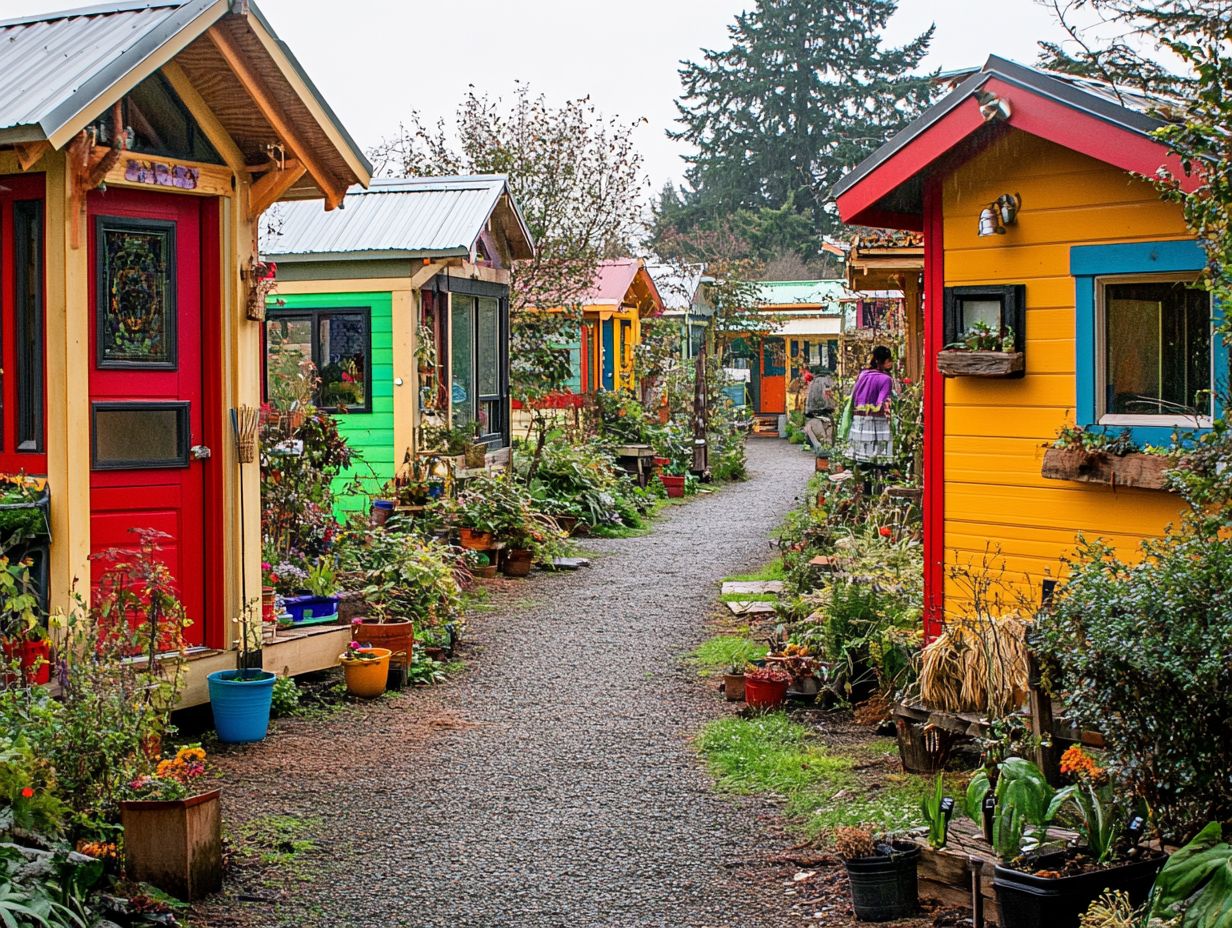
- Consider the location and surrounding area of a tiny house community before making a decision, as it can greatly affect quality of life.
- Familiarize yourself with the community’s rules and regulations to ensure they align with your lifestyle and values.
- Look for amenities and shared spaces that cater to your needs and enhance the community living experience.
1. Location and Surrounding Area
The location and surrounding area of a tiny house community are pivotal in shaping your overall living experience. Factors like accessibility, natural beauty, and local amenities significantly affect your daily routine and lifestyle.
Being part of a supportive community allows you to fully embrace a mobile lifestyle while enjoying nearby attractions, parks, and essential services that resonate with the values of tiny house living.
Take Tiny Home Village in Oregon, for example. Here, you have easy access to walking trails and recreational parks, inviting you to foster a deep connection with nature.
Similarly, Orlando Lakefront offers a stunning landscape, complete with shared resources such as gardens and community events that promote social interactions and sustainability.
The proximity to outdoor spaces enhances your well-being and actively encourages an engaged lifestyle filled with outdoor activities. These elements will enrich your experience and help you feel at home!
2. Community Rules and Regulations
Understanding community rules and regulations is crucial for anyone contemplating a tiny house. These local regulations determine whether tiny homes can thrive in specific areas and ensure adherence to zoning laws and building codes. Zoning laws dictate how land can be used, while building codes set safety standards for construction.
Familiarizing yourself with these requirements can dramatically influence whether your tiny house project becomes a success or turns into a frustrating struggle.
For example, some communities may enforce strict zoning laws that prohibit tiny homes, while others may welcome them with flexible regulations that encourage innovative living solutions.
In Seattle, tiny homes are embraced under certain conditions, promoting alternative housing options. Conversely, regions in California often impose more rigid standards, complicating the process.
This variation in local regulations can make or break your tiny house living dream, underscoring the importance for prospective homeowners to conduct thorough research and secure the necessary building permits before embarking on their journey.
3. Amenities and Shared Spaces
Amenities and shared spaces in tiny house communities elevate your quality of life, providing ample opportunities for socialization and fostering a genuine sense of belonging among residents.
These features, like community gardens where you can cultivate your own fresh produce, not only promote self-sufficiency but also instill a shared responsibility for sustainable living.
Imagine stepping into outdoor living areas adorned with comfortable seating and inviting fire pits, perfect for gatherings that create a warm, welcoming atmosphere for neighbors to connect.
Shared recreational spaces, often equipped with facilities for games or fitness activities, encourage an active lifestyle while nurturing friendships. This thoughtful integration of amenities plays a vital role in supporting a minimalist lifestyle, where simplicity and community engagement flourish together.
4. Community Dynamics and Social Activities
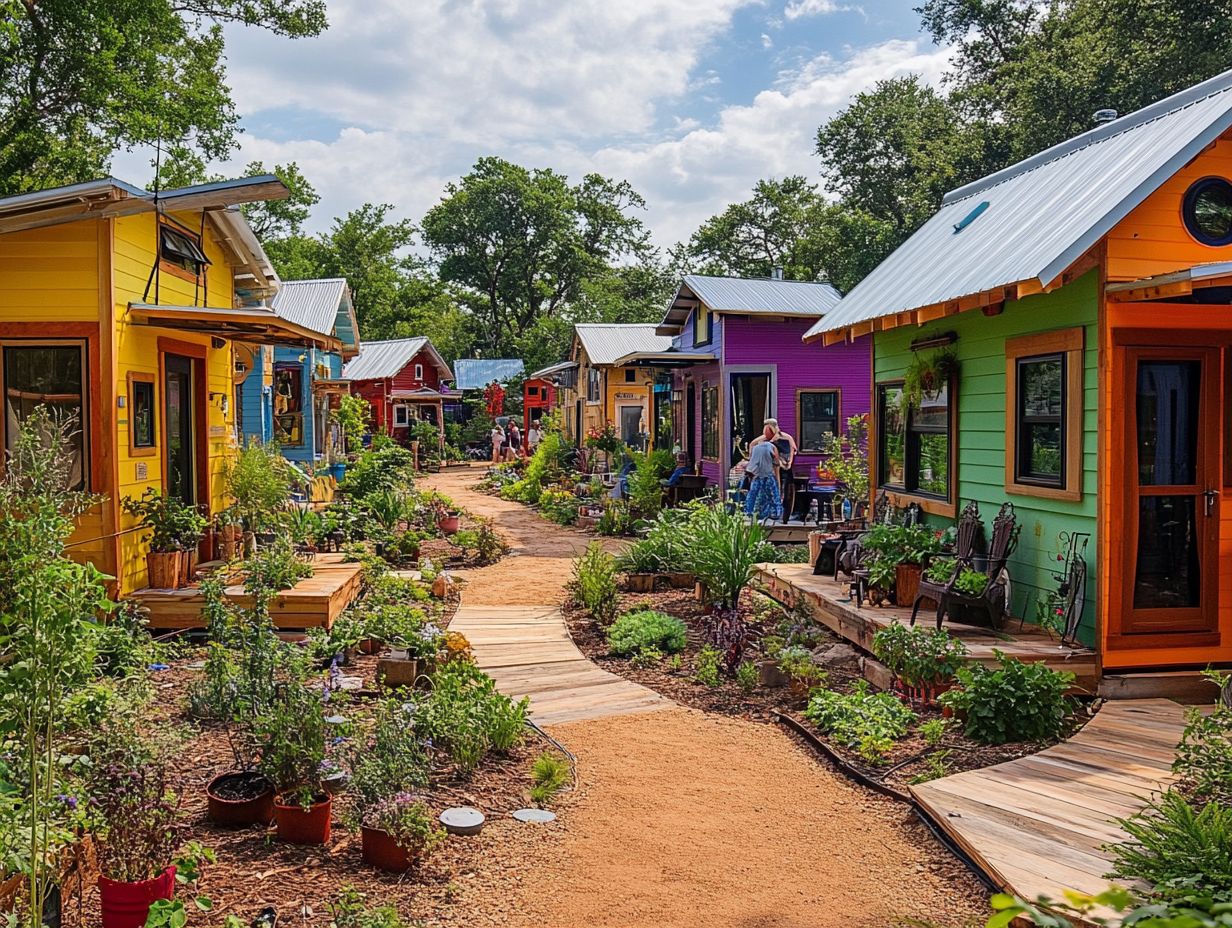
Community dynamics and social activities are vital in tiny house living. They foster interaction and create supportive networks where you can share experiences and resources.
In these close-knit communities, gatherings like potlucks invite you to bring your favorite dishes. This opens doors to culinary exploration and cultural exchange.
Workshops provide exciting opportunities for skill-sharing, teaching you everything from DIY home repairs to sustainable gardening practices. This enhances your toolkit for independent living.
Community meetings provide a platform for group decisions. You can voice your thoughts and concerns, which further strengthens those vital connections. These interactions not only enrich your living environment but also foster lasting friendships. This gives you a reliable support system in times of need, reinforcing the essential fabric of community life.
5. Cost and Affordability
Cost and affordability are pivotal in the tiny house movement. Many individuals seek alternatives to traditional home ownership that resonate with their financial goals and lifestyle choices.
If you re considering a simpler life, tiny house living presents an array of financial benefits. These go far beyond just saving on a mortgage. By cutting down on utility bills and maintenance expenses, you can free up capital for other investments.
You might explore rental opportunities as well. Utilize your tiny home as a vacation rental or short-term stay, creating an additional income stream.
This proactive approach bolsters your financial stability and champions sustainability. It reduces resource consumption and fosters a lifestyle that celebrates minimalism and efficiency.
Why Tiny House Communities Are Transforming Lives
Tiny house communities are part of an emerging trend in sustainable living. They attract individuals who embrace a minimalist lifestyle and recognize the positive environmental impact of downsizing.
In these communities, you enjoy the benefits of shared resources and a supportive atmosphere. They thrive on core principles of sustainability, simplicity, and social interaction.
Several factors contribute to their rising popularity, including escalating housing costs, heightened environmental awareness, and the quest for a more intentional existence.
By choosing to live in a smaller space, you re encouraged to minimize your possessions, reduce your ecological footprint, and cultivate genuine connections with your neighbors.
This lifestyle champions the use of renewable resources, shared amenities, and community gardens. Ultimately, it enhances both your personal well-being and the health of our planet.
What Are the Different Types of Tiny House Communities?
Various types of tiny house communities cater to your unique needs and preferences. Each offers distinct resources and environments for those pursuing a mobile lifestyle.
- Eco-villages: Emphasize sustainable living, featuring communal gardens, renewable energy sources, and educational workshops that promote environmental stewardship.
- RV parks: Provide traditional amenities like access to water, electricity, and waste disposal. They are a practical choice for those who love to travel.
- Intentional communities: Cultivate a sense of belonging with shared spaces for gatherings and collaborative projects. This enables you to forge strong social ties while embracing a minimalist lifestyle.
Each type of community brings its own flavor of support and resources, enhancing your tiny house experience in meaningful ways.
Ready to embrace tiny house living? Explore 5 unique tiny house styles to consider and join a community today!
Discover the Perks of Tiny House Living!
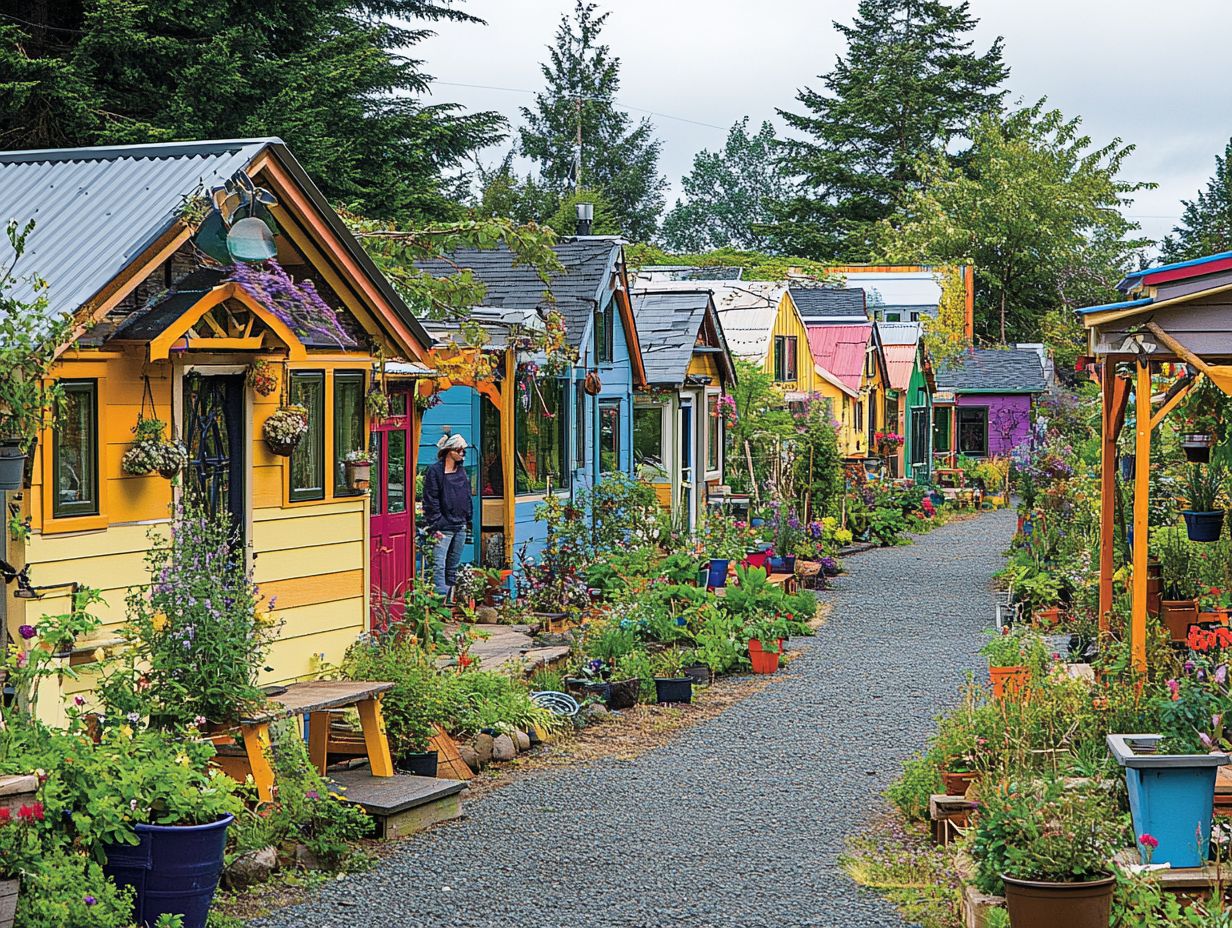
Experience the amazing benefits of living in a tiny house community! Enjoy a vibrant sense of community, access to shared outdoor spaces, and a reduced environmental footprint that enables a financially sustainable lifestyle.
But that’s not all! These communities foster rich social interactions. Neighbors come together for potlucks and events, forging lasting friendships. The cost savings from shared resources like laundry facilities and garden plots can be substantial many report slashing living costs by up to 50%.
Shared amenities such as community fire pits, playgrounds, and fitness areas promote a more active lifestyle. Families often find their children thriving in this setting, playing together and developing invaluable social skills for the future.
What Are the Potential Challenges of Living in a Tiny House Community?
While living in a tiny house community offers numerous advantages, it also presents challenges to navigate. Consider the dynamics of community living and the shift to a lifestyle that values simplicity.
Transitioning to a compact living space can be overwhelming. You may grapple with limited room for personal belongings and will need to prioritize what’s truly essential. Conflicts can arise over shared resources like communal kitchens or outdoor living areas, so open communication is vital.
Adjusting to this lifestyle is no small feat. Embracing these challenges can lead to a more enriching life. To cultivate harmony, consider incorporating daily routines that enhance collective well-being:
- Participate in regular meetings to voice concerns.
- Create a shared resource calendar to sidestep conflicts.
- Engage in workshops that promote skills like efficient organizing and sustainable living.
How Can One Find the Right Tiny House Community for Them?
Finding the right tiny homes community is a crucial step in your journey. Thoughtfully consider your needs, preferences, and the community resources available.
Evaluate these elements to ensure your chosen community aligns with your lifestyle goals. Start by researching various locations that interest you, including the top tiny house communities in the USA, while keeping in mind proximity to essential amenities like grocery stores and healthcare facilities.
Next, look closely at the amenities within the community. Some may feature shared gardens, workshops, or communal spaces that foster a nurturing atmosphere. Don’t overlook community dynamics; observing social interactions and engaging with residents can provide invaluable insights into whether the environment aligns with your desired sense of belonging.
Don’t wait! Start exploring your options today!
What Are the Long-Term Prospects of Living in a Tiny House Community?
The long-term prospects of living in a tiny home community offer unique opportunities. This lifestyle focuses on sustainability, community engagement, and financial independence.
As the minimalist lifestyle gains traction, expect emerging trends that emphasize green technologies products or practices that are beneficial for the environment shared resources, and collective decision-making. Such communities may transform into vibrant hubs, encouraging environmental stewardship while nurturing meaningful social connections among neighbors.
With a growing awareness of climate change, you’ll likely collaborate on projects like community gardens and renewable energy initiatives. This ensures your tiny living space contributes positively to the planet. This shift toward communal responsibility may redefine traditional housing concepts, highlighting the benefits of living in a tiny house community, making tiny house living an appealing choice for future generations seeking harmony between modern living and ecological mindfulness.
Frequently Asked Questions
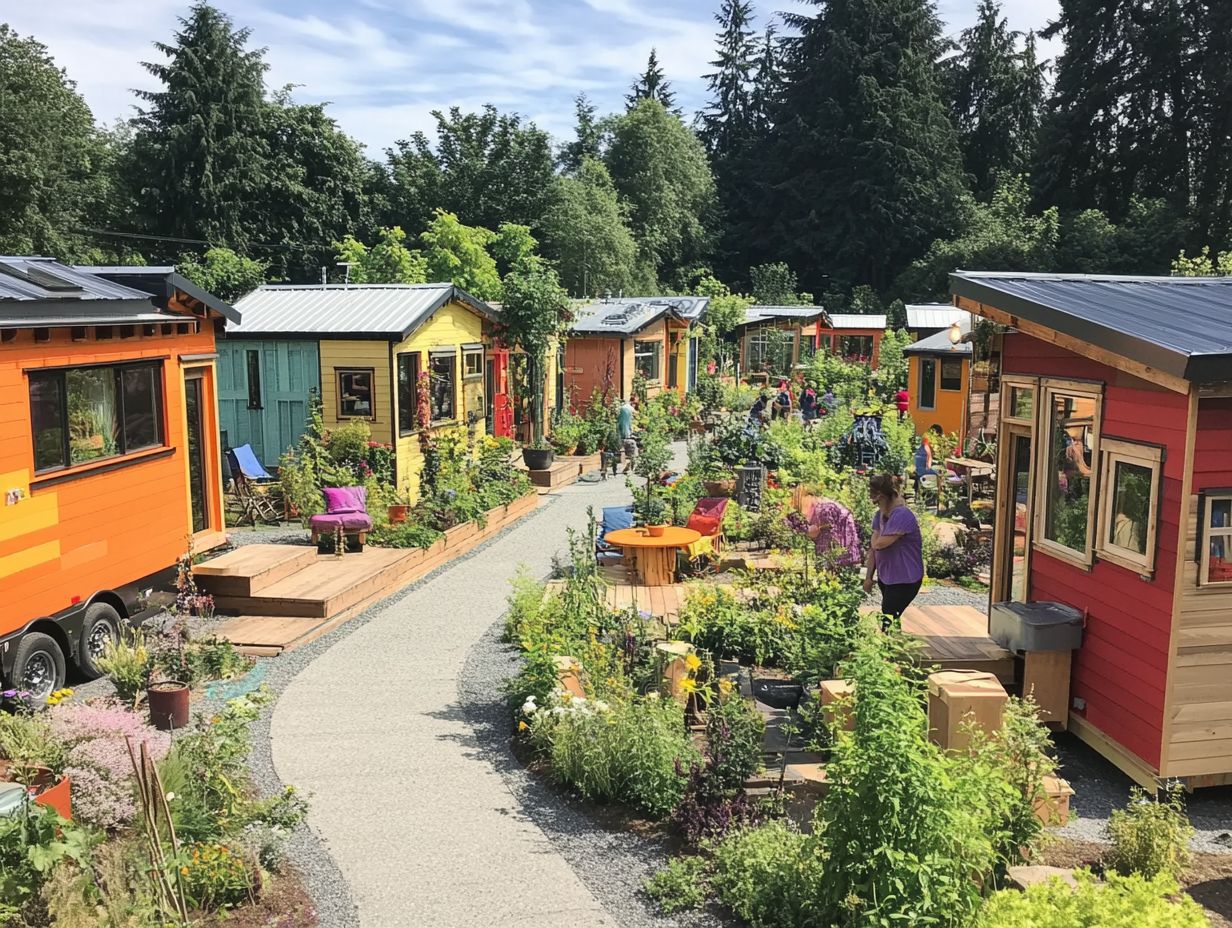
What are the top 5 things to look for in tiny house communities?
The top 5 things to look for in tiny house communities are location, amenities, local regulations, sustainability practices, and a sense of community.
What factors should I consider when choosing a location for a tiny house community?
When choosing a location for a tiny house community, consider factors such as accessibility to essential services, zoning laws, proximity to recreational activities, and potential for community growth.
What type of amenities should I expect in a tiny house community?
Tiny house communities may offer a variety of amenities, including shared outdoor spaces, laundry facilities, communal gardens, and meeting spaces for community events, all of which contribute to a mobile lifestyle.
What kind of rules do most tiny house communities have?
Most tiny house communities establish rules regarding the size and design of homes, parking regulations, and community guidelines for shared spaces and resources, ensuring adherence to building codes.
How can I ensure a tiny house community is sustainable?
To ensure a tiny house community is sustainable, look for features such as eco-friendly building materials, renewable energy sources, and sustainable waste management practices.
What is the importance of a sense of community in tiny house communities?
A strong sense of community makes tiny house living special. It creates an inclusive environment where everyone feels connected and supported, enhancing the many benefits of living simply.

